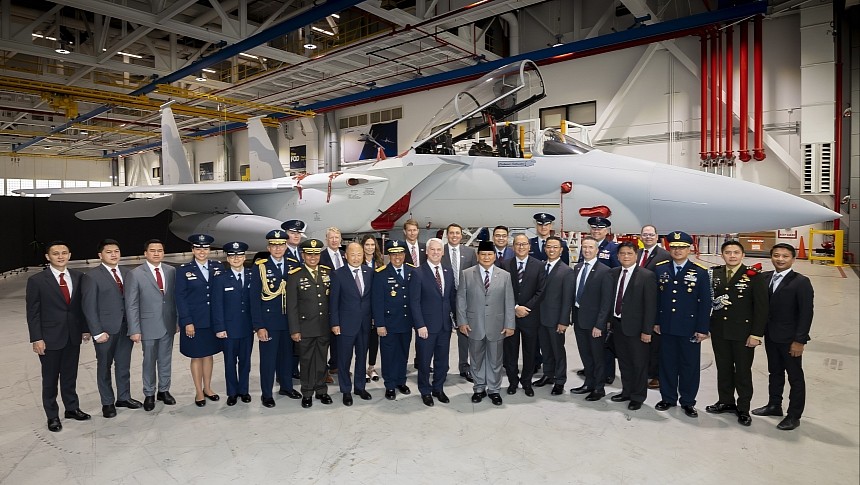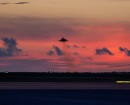Questions about whether fourth-generation jet fighters have a place on a modern battlefield between two peer-to-peer superpowers continue to abound in contemporary aviation circles. But Boeing and the U.S. Air Force are confident that the F-15EX Eagle II will be a force to be reckoned with against Sukhois and Chengdus of Russia and China, regardless of the generation. It's to the point that even U.S. allies can't help but take an interest. Among that crowd, it's Indonesia that's getting the first crack at a production contract.
That's right. It's not Japan or Saudi Arabia that's become the second country outside the U.S. and Israel to get dibs on the ultimate form of the most F-15 platform. On Aug 21st, Boeing announced that a deal with Indonesia's Minister of Defense, Prabowo Subianto, had been reached, pending federal approval, to be the first nation outside the U.S. to agree to acquire the Eagle II. The mutually agreed signing of what's known as a Moratorium of Understanding (MoU) after the two parties toured the Boeing production facility in St Louis, MO, will make Indonesia, a country with a population nearly at parity with the U.S., among the first of its allies to commit to a gen-4.5 airframe with lots to prove.
Dubbed the F-15ID, the Indonesian Eagle II will have the same astonishing weapons capacity, ultra-modern weapons systems not limited to just new hypersonic air-to-air-missiles, and 50-year strong airframe architecture that, even to this day, has yet to be shot down in combat. If anything, F-15s are far more likely to be lost in accidents than by enemy combatants. The facts and figures back this up ten times out of ten. From the new General Electric F110 engines jetting 29,000 lb (129 kN) of thrust each at full afterburner to the Raytheon AESA radar and the BAE Systems electronic warfare/countermeasures pods, there's no questioning why Indonesia's vast coastlines would be better protected by the Eagle II.
As mentioned above, only the Israelis were quicker to obtain contracts with Boeing for the Eagle II, dubbed the F-15IA. For an Air Force only 224 airframes strong, an Indonesian Air Force roughly a third the size of Israel's by flying stock will soon fly a jet well-suited to defending its airspace against powerful adversaries. Compared to the borderline antiquated F-16 Block 15s and Sukhoi Su-27/30s native to Indonesia's Air Force already, the extra "horsepower" from an F-15 with near fifth-gen capabilities speaks for itself. This tech includes a much-reduced radar cross-section, by the way.
24 total Eagle II airframes are headed to Indonesia, pending any legal challenges that may or may not come from the U.S. Government. But once all the paperwork is sorted, there's no reason why squadrons of Eagle IIs are flying with the Indonesian Air Force well before this decade is out.
Dubbed the F-15ID, the Indonesian Eagle II will have the same astonishing weapons capacity, ultra-modern weapons systems not limited to just new hypersonic air-to-air-missiles, and 50-year strong airframe architecture that, even to this day, has yet to be shot down in combat. If anything, F-15s are far more likely to be lost in accidents than by enemy combatants. The facts and figures back this up ten times out of ten. From the new General Electric F110 engines jetting 29,000 lb (129 kN) of thrust each at full afterburner to the Raytheon AESA radar and the BAE Systems electronic warfare/countermeasures pods, there's no questioning why Indonesia's vast coastlines would be better protected by the Eagle II.
As mentioned above, only the Israelis were quicker to obtain contracts with Boeing for the Eagle II, dubbed the F-15IA. For an Air Force only 224 airframes strong, an Indonesian Air Force roughly a third the size of Israel's by flying stock will soon fly a jet well-suited to defending its airspace against powerful adversaries. Compared to the borderline antiquated F-16 Block 15s and Sukhoi Su-27/30s native to Indonesia's Air Force already, the extra "horsepower" from an F-15 with near fifth-gen capabilities speaks for itself. This tech includes a much-reduced radar cross-section, by the way.
24 total Eagle II airframes are headed to Indonesia, pending any legal challenges that may or may not come from the U.S. Government. But once all the paperwork is sorted, there's no reason why squadrons of Eagle IIs are flying with the Indonesian Air Force well before this decade is out.



















